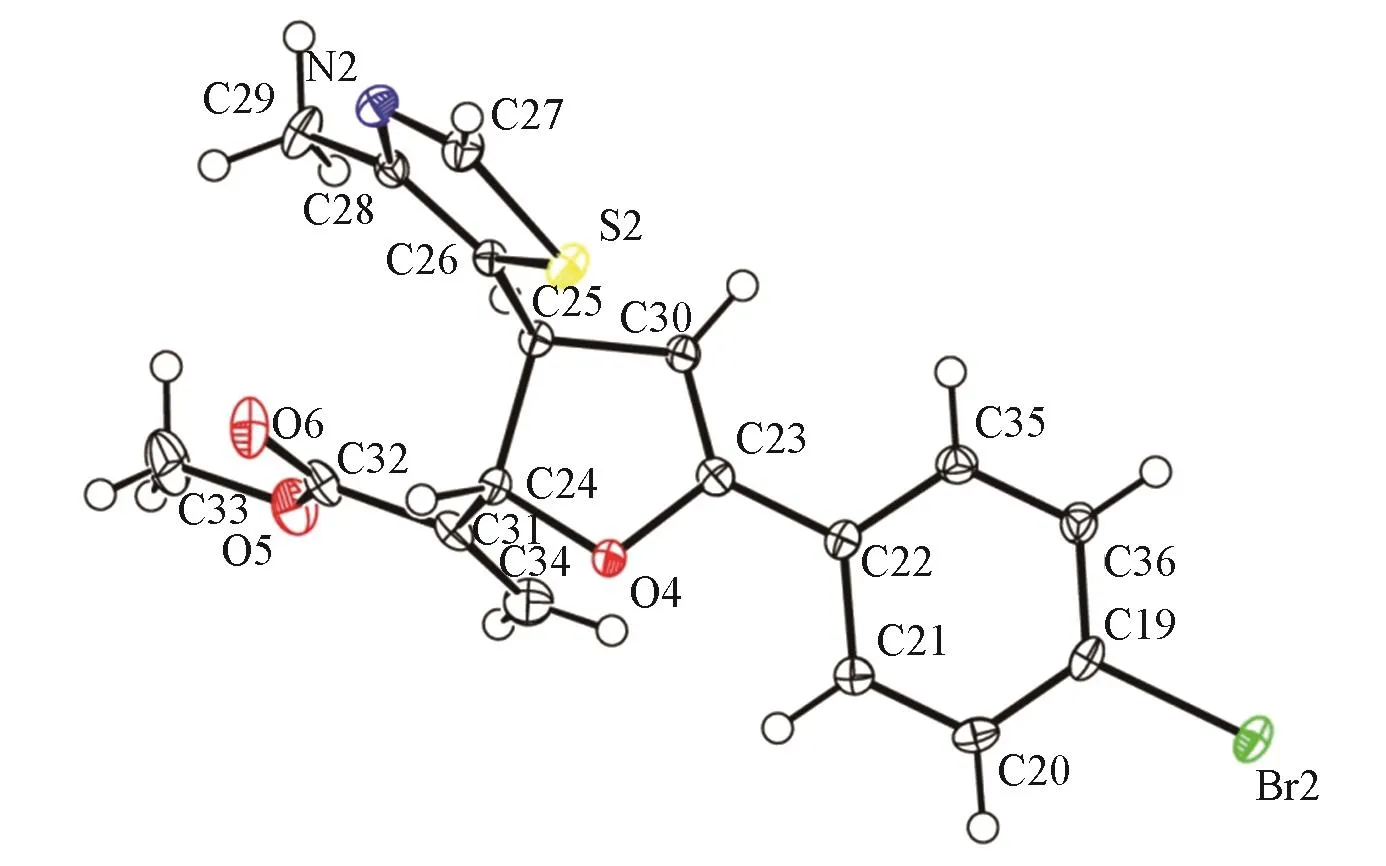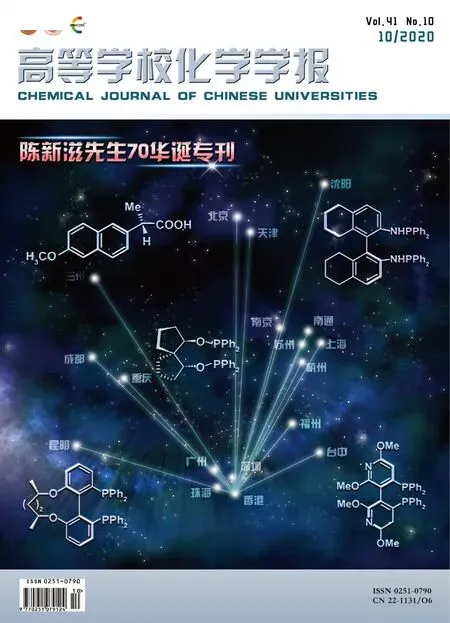不对称有机催化MBH 碳酸酯与噻唑基烯酮的[1+4]环化反应构建含有噻唑骨架的手性二氢呋喃衍生物
刘 畅,张鹏飞,李鹏飞,2
(1.南方科技大学理学院化学系,深圳518055;2.华南理工大学广东省功能分子工程重点实验室,广州510006)
1 Introduction
Heterocycles are fundamental structural scaffolds in abundant natural products,synthetic agrochemicals,pharmaceuticals, biophotonic materials and key ligands in homogeneous catalysis[1—6]. Particularly,1,3-thiazole is one of the most important scaffolds in heterocyclic chemistry and drug design and discovery[Scheme 1(A)][7—9].On the other hand,optically active 2,3-dihydrofuran scaffolds are found in a wide variety of bioactive molecules and natural products[Scheme 1(B)][10—18].The combination of those two active substructures into one target molecule might lead to the creation of a new group of heterocycles with potentially interesting biological properties[Scheme 1(C)].Although abundant synthetic strategies have been developed for the synthesis of structurally diversified heterocycles[19—24],the general protocol towards such nature-inspired synthetic targets has not been reported.Accordingly,developing a robust method for the direct synthesis of thiazole-containing 2,3-dihydrofuran derivatives from readily available starting materials remains desirable.

Scheme 1 Relevance of 1,3-thiazole and 2,3-dihydrofuran scaffolds and the synthetic objectives
Recently,thiazolyl enones have been successfully employed to synthesize many thiazole-derivatives with a wide spectrum of biological activities[25—29],which provided a direct and efficient access to thiazole-containing frameworks.Furthermore,we have prepared diversified enantioenriched 2,3-dihydrofuran derivatives via a phosphine catalyzed[1+4]-annulation of Morita-Baylis-Hillman(MBH)carbonates with a series of electrondeficient olefins including β,γ-unsaturated α-keto esters,chalcones,2-enoylpyridines,o-quinone methides,2-enoylpyridine N-oxides,and α,β-unsaturated imines[30—34].As a continuation of our interesting in developing asymmetric annulations[35—41],herein,we aimed to develop an organocatalytic asymmetric annulations between MBH carbonates and thiazolyl enones[Scheme 1(D)].Notably,this annulation not only provided a facile approach towards enantioenriched thiazole-containing 2,3-dihydrofuran derivatives[42—53],but also explored the scope of the phosphine catalyzed[1+4]-annulation of MBH carbonates[54—60].
2 Experimental
2.1 Reagents and Instruments
All the reactions were carried out with dry,freshly distilled solvents in anhydrous conditions.All the chemicals were used without further purification as commercially available unless otherwise noted.All the reactions were performed under an atmosphere of dry argon.
Thin-layer chromatography(TLC)was performed on silica gel plates(60F-254)using ultraviolet light(UV,254 and 365 nm).Flash chromatography was conducted on silica gel(300—400 mesh).Nuclear magnetic resonance[Bruker Avance Ⅲ(400 MHz)NMR spectrometer,400 MHz for1H NMR,100 MHz for13C NMR]spectra were recorded in CDCl3with tetramethylsilane(TMS)as the internal standard.Chemical shifts were reported in δ and coupling constants were given in Hz.Data for1H NMR were recorded as follows:chemical shift(δ),coupling constant(Hz),integration.Data for13C NMR were reported in terms of chemical shift(δ).High resolution mass spectral(HRMS)analyses were measured using electrospray ionization(ESI)techniques(Thermo Scientific Q Exactive mass spectrometer).
2.2 General Procedure
Under argon atmosphere,a mixture of thiazolyl enone(1a,0.20 mmol),MBH carbonate(2a,0.3 mmol)and catalyst P-1(0.02 mmol)in MeCN(1.0 mL)was stirred at room temperature in a sealed tube for 48 h.After removal of the solvent,the crude residue was purified by column chromatography(petroleum ether/ethyl acetate)on silica gel to give the corresponding product 3aa.Accordingly,other chiral 2,3-dihydrofurans were prepared from the P-1 catalyzed reactions between thiazolyl enones 1 and MBH carbonates 2.
3 Results and Discussion
3.1 Optimization of Reaction Condition
With high motivation,we began our investigation with the model reaction between 3-(4-methylthiazol-5-yl)-1-phenylprop-2-en-1-one(1a)and 2-(methoxycarbonyl)allylt-butyl carbonate(2a)(Table 1).First of all,we revisited the prototypical catalyst system[30—34].To our delight,enone 1a reacted smoothly with MBH carbonate 2a in MeCN to furnish the desired thiazole-containing 2,3-dihydrofuran(3aa)in yield of 91%withe.e.of 98%andd.r.more than 20∶1 when 1,2-bis[(2R,5R)-2,5-dimethylphospholano]-benzene monoxide(P-1)was employed as catalyst(Table 1,entry 1).In the presence of(-)-1,2-bis[(2R,5R)-2,5-dimethylphospholano]benzene(P-2),the desired product 3aa was obtained in yield of 68%withe.e.of 96%andd.r.more than 20∶1(Table 1,entry 2).Several popular phosphine based catalysts were also screened,and poor results were obtained(Table 1,entries 3—6)[61—66].The screening of reaction media indicated that MeCN was more suitable for the transformation(Table 1,entries 7—10).Increasing the amount of MBH carbonate to 0.4 mmol led to the decreasing of effective concentration,resulting in the formation of product 3aa in yield of 70%without compromising the stereoselectivity(Table 1,entry 11).The effect of reaction time was also surveyed,neither shorting nor prolonging reaction time afforded more than in yield of 75%(Table 1,entries 12 and 13).Notably,we identified the following optimal protocol:the mixture of enone(1a,0.2 mmol),MBH carbonate(2a,0.3 mmol),and catalyst P-1(0.02 mmol)in MeCN(1.0 mL)was stirred at room temperatur(r.t.)for 48 h,the desired 2,3-dihydrofuran featuring 1,3-thiazole motif(3aa)was obtained in yield of 91%withe.e.of 98%andd.r.more than 20∶1.

Table 1 Optimization results of reaction condition*
3.2 Scope of the P-1 Catalyzed[1+4]-annulation
Under the optimal reaction conditions,we then examined the substrate scope of the[1+4]-annulation.The scope of MBH carbonates 2 was investigated by the P-1 catalyzed[1+4]-annulation of enone 1a.As shown in Scheme 2,the reaction of 2-(methoxycarbonyl)allyl t-butyl carbonate(2a)furnished product 3aa in yield of 91%with e.e.of 98%and d.r.more than 20∶1.Using 2-(n-butoxycarbonyl)allyl t-butyl carbonate(2b)enabled the formation of product 3ab in yield of 75%with e.e.of 98%and d.r.more than 20∶1.The sterically more congested 2-(isobutoxycarbonyl)allyl t-butyl carbonate(2c)also reacted smoothly to afford the corresponding product 3ac in yield of 78%with e.e.of 98%and d.r.more than 20∶1.Obviously,the ester group of MBH carbonates had a little effect on the yield without affecting the asymmetric induction.The scope of thiazole-based enones 1 was also surveyed by the P-1 catalyzed[1+4]-annulation of MBH carbonate 2a.Notably,the P-1 catalyzed[1+4]-annulations were applicable to a broad scope of thiazolyl enones 1b—1p with different substituents,furnishing the desired products 3ba—3pa in yields of 49%—96%with e.e.of 92%—98%and d.r.from 6∶1 to more than 20∶1.In particular,various substituents(R2),including electron-withdrawing(F,Cl,Br,NO2)and electron-donating groups(Me,MeO)could be introduced into the aromatic ring of thiazolyl enones 1b—1p.It was found that the substituent R2had a slight effect on the enantioselectivity but a noticeable effect on yield and diastereoselectivity.The reaction of 1-phenyl-3-(thiazol-5-yl)prop-2-en-1-one(1q,R1=R2=H)also proceeded smoothly to afford the corresponding product 3qa in yield of 56%with e.e.of 99%and d.r.more than 20∶1.Taken altogether,the encouraging results demonstrated that the phosphine catalyzed[1+4]-annulation of MBH carbonates was successfully extended to thiazolyl eneones,providing a facile access to a series of optically active thiazole-containing 2,3-dihydrofuran derivatives.

Scheme 2 Scope of the reaction under the standard conditions
The absolute configuration of product 3oa was determined by single-crystal X-ray diffraction analysis(CCDC No.1958948,Fig.1).Accordingly,the absolute configurations of other products 3 were assigned by analogy.
In terms of reaction mechanism(Scheme 3),the organocatalyst P-1 was expected to attack MBH carbonate to eliminate the leaving group(OB-oc)and deliver the phosphonium salt intermediate M-1.Allylic phosphorus ylides M-2 was obtained from the deprotonation of M-1 by anin situgenerated base(t-BuO).Via β-selectivity,Michael addition between M-2 and thiazolyl enone afforded the chiral precursor of 2,3-dihydrofuran M-3,followed by the intramolecular annulation to furnish the target product and regenerate catalyst P-1.Alternatively,Michael addition of M-2 to thiazolyl enone occurredvia γ-selectivity to furnish intermediate M-4,which isomerized easily to form intermediate M-5.The intramolecular Michael addition of M-5 afforded the desired product and regenerated catalyst P-1.

Fig.1 X-ray crystal structure of product 3oa

Scheme 3 Proposed reaction mechanism
The scale up of the reaction was also investigated.Under the standard conditions,1.0 mmol of thiazolyl enone 1a reacted smoothly with 1.5 mmol of MBH carbonate 2a to generate the product 3aa in yield of 85%withe.e.of 98%andd.r.more than 20∶1(Scheme 4).

Scheme 4 Synthetic potential of compound 3aa
4 Conclusions
In summary,we have established a phosphine catalyzed[1+4]-annulation of MBH carbonates with 1,3-thiazolyl enones.In the presence of 1,2-bis[(2R,5R)-2,5-dimethylphospholano]-benzene monoxide with a loading of 10%(molar fraction),thiazole-containing 2,3-dihydrofurans were obtained in yields of 49%—96%withe.e.of 92%—99%andd.r.from 6∶1 to more than 20∶1.Notably,this method not only provided a facile approach towards enantioenriched thiazole-containing 2,3-dihydrofuran derivatives,but also explored the scope of the phosphine catalyzed[1+4]-annulation of MBH carbonates.
This paper is supported by the National Natural Science Foundation of China(No.21871128)and the Open Fund of the Key Laboratory of Functional Molecular Engineering of Guangdong Province,China(No.2018kf01).
———理学院

